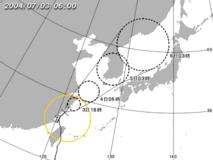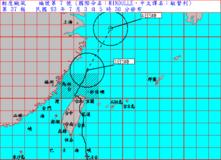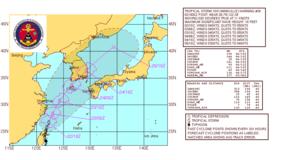2004年7月6日
台湾における台風7号(MINDULLE)の被害が引続き報道されています。死者不明は30名ほどに達し、台湾南部では最近25年ほどで最悪の洪水となったようです。場所によってはここ数日の降水量が1500mmに達したとのことですが、これは例えば東京の1年分の降水量に匹敵するという豪雨です。山間部ではまだ孤立した集落も多いとのことですが、急峻な地形の台湾にこれだけ大量の降水があれば、洪水や土砂災害の危険性はいまだ消えていないでしょう。
2004年7月4日
台風7号(MINDULLE)は、フィリピンおよび台湾に大きな被害を与えてきました。フィリピンでは各地で洪水が発生し死者不明40人以上、台湾でも死者不明数名、各所で洪水や土砂災害が発生し交通が寸断されました。その後台風は、中国・浙江省に上陸し、上海付近を通過し、今後は朝鮮半島へと進むコースが予報されています。ただし最も強い雨雲は実際には中心から南東方向に分布しており、その雨雲はまさに沖縄・九州・四国・西日本を直撃するコースを進んでいます。「日本に上陸せず」ということで警戒が緩むとすれば、大雨には注意が必要な状況といえます。
2004年7月3日
台風7号(MINDULLE)はなかなかしぶとい台風で、台湾という高い山がそびえる陸地にぶつかりながらも、その形を変幻自在に変えながら生き残っています。そして雲の形状があまりに変則的となったため、夜になって中心がどこかわからなくなってしまったようです。そんな無責任なことがあるのか、と思うかもしれませんが、実際に各国の台風予想進路図を比べてみると、それぞれの台風経路がかなり異なっていることに気付きます。
このことは、台風の中心を見失っているか、または「意見」の違いが各国で大きいということを意味します。台風の中心決定というと、簡単そうに思えるのですが、実際には一筋縄ではいかないことがわかります。なお、夜明けとともに可視画像が利用可能となりますので、中心位置決定の精度は向上するでしょう。
| 気象庁(日本) | 中央氣象局(台湾) | 米軍合同台風警報センター(米国) |
|---|---|---|

|

|

|
| 台湾北部を縦断した後、中国沿岸に接近し、中国沿岸を進んでいる。 | 台湾北部を縦断した後、すぐに進行方向を変え、東シナ海を進んでいる。 | 台湾北部は縦断せず、台湾東部をかすめて(上陸して)、東シナ海を進んでいる。 |
2004年7月1日
台風7号(MINDULLE)は、最盛期に比べると勢力が衰えてきましたが、相変わらずフィリピンと台湾の間をノロノロ進んでいます。進路予想は既に何度も変更されており、進路予測がたいへん難しい台風です。現在のコースを進むと、今後は先島諸島でも高波や強風の影響が強まりそうです。
2004年6月29日
台風7号(MINDULLE)は、数日前の状態からは見違えるほどよく発達した台風となりました。今後もノロノロとした動きが続き、しかも勢力が強まっているため、ルソン島北部や台湾南部は激しい風雨が長時間にわたって続く可能性があります。
- 太平洋上に相並ぶ台風200407号と台風200408号(12時JST) -- 1024x768 (VIS) [東西4000km x 南北3000km]
2004年6月28日
台風7号(MINDULLE)は昨日からようやく発達を始め、今日は大きな眼もはっきりと見える成熟した台風となりました。今後の進路については、予想が分かれているようです。
- 台風200407号の大きな眼(15時JST) -- 1024x768 (VIS) [東西1600km x 南北1200km]
2004年6月25日
台風7号(MINDULLE)の雲の分布は、かなり大きく偏っています。一見すると大きな雲の塊が台風の中心に見えますが、よく見てみると台風の中心はそれよりも北東側にあります。下の画像で+印が台風の中心です。台風は今後もしばらくは西に進み、フィリピン沖に達するとの予報が出ています。
- 台風200407号の中心はどこ?(12時JST) -- 1024x768 (VIS) [東西1600km x 南北1200km]
2004年6月23日
台風7号(MINDULLE)が太平洋のマリアナ諸島で発生しました。今のところはまだ小さめの台風のようです。それにしても今年の6月はこれで4個目の台風。6月7日以来ほぼ切れ目なく台風が続いています。
リンク集
-
EO Natural Hazards: Typhoon Mindulle
NASAによる台風MINDULLEの画像。
http://earthobservatory.nasa.gov/NaturalHazards/natural_hazards_v2.php3?img_id=12219
-
EO Natural Hazards: Floods in Southern Taiwan
NASAによる台湾南部の洪水の衛星画像。
http://earthobservatory.nasa.gov/NaturalHazards/natural_hazards_v2.php3?img_id=12225
関連する台風ブログ記事
2025
2024
- 2024年台風のまとめ
- 2024年台風26号(パブーク|PABUK)
- 2024年台風25号(ウサギ|USAGI)
- 2024年台風24号(マンニィ|MAN-YI)
- 2024年台風23号(トラジー|TORAJI)
- 2024年台風22号(インシン|YINXING)
- 2024年台風21号(コンレイ|KONG-REY)
- 2024年台風20号(チャーミー|TRAMI)
- 2024年台風19号(バリジャット|BARIJAT)
- 2024年台風18号(クラトーン|KRATHON)
- 2024年台風17号(チェービー|JEBI)
- 2024年台風16号(シマロン|CIMARON)
- 2024年台風15号(ソーリック|SOULIK)
- 2024年台風14号(プラサン|PULASAN)
- 2024年台風13号(バビンカ|BEBINCA)
- 2024年台風12号(リーピ|LEEPI)
- 2024年台風11号(ヤギ|YAGI)
- 2024年台風10号(サンサン|SHANSHAN)
- 2024年台風9号(ジョンダリ|JONGDARI)
- 2024年台風8号(ウーコン|WUKONG)
- 2024年台風7号(アンピル|AMPIL)
- 2024年台風6号(ソンティン|SON-TINH)
- 2024年台風5号(マリア|MARIA)
- 2024年台風4号(プラピルーン|PRAPIROON)
- 2024年台風3号(ケーミー|GAEMI)
- 2024年台風2号(マリクシ|MALIKSI)
- 2024年台風1号(イーウィニャ|EWINIAR)
2023
- 2023年台風のまとめ
- 2023年台風17号(ジェラワット|JELAWAT)
- 2023年台風16号(サンバ|SANBA)
- 2023年台風15号(ボラヴェン|BOLAVEN)
- 2023年台風14号(コイヌ|KOINU)
- 2023年台風13号(インニョン|YUN-YEUNG)
- 2023年台風12号(キロギー|KIROGI)
- 2023年台風11号(ハイクイ|HAIKUI)
- 2023年台風10号(ダムレイ|DAMREY)
- 2023年台風9号(サオラー|SAOLA)
- 2023年台風8号(ドーラ|DORA)
- 2023年台風7号(ラン|LAN)
- 2023年台風6号(カーヌン|KHANUN)
- 2023年台風5号(トクスリ|DOKSURI)
- 2023年台風4号(タリム|TALIM)
- 2023年台風3号(グチョル|GUCHOL)
- 2023年台風2号(マーワー|MAWAR)
- 2023年台風1号(サンヴー|SANVU)
2022
- 2022年台風のまとめ
- 2022年台風25号(パカー|PAKHAR)
- 2022年台風24号(ヤマネコ|YAMANEKO)
- 2022年台風23号(バンヤン|BANYAN)
- 2022年台風22号(ナルガエ|NALGAE)
- 2022年台風21号(ハイタン|HAITANG)
- 2022年台風20号(ネサット|NESAT)
- 2022年台風19号(ソンカー|SONCA)
- 2022年台風18号(ロウキー|ROKE)
- 2022年台風17号(クラー|KULAP)
- 2022年台風16号(ノルー|NORU)
- 2022年台風15号(タラス|TALAS)
- 2022年台風14号(ナンマドル|NANMADOL)
- 2022年台風13号(マールボック|MERBOK)
- 2022年台風12号(ムイファー|MUIFA)
- 2022年台風11号(ヒンナムノー|HINNAMNOR)
- 2022年台風10号(トカゲ|TOKAGE)
- 2022年台風9号(マーゴン|MA-ON)
- 2022年台風8号(メアリー|MEARI)
- 2022年台風7号(ムーラン|MULAN)
- 2022年台風6号(トローセス|TRASES)
- 2022年台風5号(ソングダー|SONGDA)
- 2022年台風4号(アイレー|AERE)
- 2022年台風3号(チャバ|CHABA)
- 2022年台風2号(メーギー|MEGI)
- 2022年台風1号(マラカス|MALAKAS)
2021
- 2021年台風のまとめ
- 2021年台風22号(ライ|RAI)
- 2021年台風21号(ニヤトー|NYATOH)
- 2021年台風20号(マーロウ|MALOU)
- 2021年台風19号(ナムセーウン|NAMTHEUN)
- 2021年台風18号(コンパス|KOMPASU)
- 2021年台風17号(ライオンロック|LIONROCK)
- 2021年台風16号(ミンドゥル|MINDULLE)
- 2021年台風15号(ディアンムー|DIANMU)
- 2021年台風14号(チャンスー|CHANTHU)
- 2021年台風13号(コンソン|CONSON)
- 2021年台風12号(オーマイス|OMAIS)
- 2021年台風11号(ニーダ|NIDA)
- 2021年台風10号(ミリネ|MIRINAE)
- 2021年台風9号(ルピート|LUPIT)
- 2021年台風8号(ニパルタック|NEPARTAK)
- 2021年台風7号(チャンパカ|CEMPAKA)
- 2021年台風6号(インファ|IN-FA)
- 2021年台風5号(チャンパー|CHAMPI)
- 2021年台風4号(コグマ|KOGUMA)
- 2021年台風3号(チョーイワン|CHOI-WAN)
- 2021年台風2号(スリゲ|SURIGAE)
- 2021年台風1号(ドゥージェン|DUJUAN)
2020
- 2020年台風のまとめ
- 2020年台風23号(クロヴァン|KROVANH)
- 2020年台風22号(ヴァムコー|VAMCO)
- 2020年台風21号(アータウ|ETAU)
- 2020年台風20号(アッサニー|ATSANI)
- 2020年台風19号(コーニー|GONI)
- 2020年台風18号(モラヴェ|MOLAVE)
- 2020年台風17号(ソウデル|SAUDEL)
- 2020年台風16号(ナンカー|NANGKA)
- 2020年台風15号(リンファ|LINFA)
- 2020年台風14号(チャンホン|CHAN-HOM)
- 2020年台風13号(クジラ|KUJIRA)
- 2020年台風12号(ドルフィン|DOLPHIN)
- 2020年台風11号(ノウル|NOUL)
- 2020年台風10号(ハイシェン|HAISHEN)
- 2020年台風9号(メイサーク|MAYSAK)
- 2020年台風8号(バービー|BAVI)
- 2020年台風7号(ヒーゴス|HIGOS)
- 2020年台風6号(メーカラー|MEKKHALA)
- 2020年台風5号(チャンミー|JANGMI)
- 2020年台風4号(ハグピート|HAGUPIT)
- 2020年台風3号(シンラコウ|SINLAKU)
- 2020年台風2号(ヌーリ|NURI)
- 2020年台風1号(ヴォンフォン|VONGFONG)
2019
- 2019年台風のまとめ
- 2019年台風29号(ファンフォン|PHANFONE)
- 2019年台風28号(カンムリ|KAMMURI)
- 2019年台風27号(フォンウォン|FUNG-WONG)
- 2019年台風26号(カルマエギ|KALMAEGI)
- 2019年台風25号(フンシェン|FENGSHEN)
- 2019年台風24号(ナクリー|NAKRI)
- 2019年台風23号(ハーロン|HALONG)
- 2019年台風22号(マットゥモ|MATMO)
- 2019年台風21号(ブアローイ|BUALOI)
- 2019年台風20号(ノグリー|NEOGURI)
- 2019年台風19号(ハギビス|HAGIBIS)
- 2019年台風18号(ミートク|MITAG)
- 2019年台風17号(ターファー|TAPAH)
- 2019年台風16号(ペイパー|PEIPAH)
- 2019年台風15号(ファクサイ|FAXAI)
- 2019年台風14号(カジキ|KAJIKI)
- 2019年台風13号(レンレン|LINGLING)
- 2019年台風12号(ポードル|PODUL)
- 2019年台風11号(バイルー|BAILU)
- 2019年台風10号(クローサ|KROSA)
- 2019年台風9号(レキマー|LEKIMA)
- 2019年台風8号(フランシスコ|FRANCISCO)
- 2019年台風7号(ウィパー|WIPHA)
- 2019年台風6号(ナーリー|NARI)
- 2019年台風5号(ダナス|DANAS)
- 2019年台風4号(ムーン|MUN)
- 2019年台風3号(セーパット|SEPAT)
- 2019年台風2号(ウーティップ|WUTIP)
- 2019年台風1号(パブーク|PABUK)
2018
- 2018年台風のまとめ
- 2018年台風29号(ウサギ|USAGI)
- 2018年台風28号(マンニィ|MAN-YI)
- 2018年台風27号(トラジー|TORAJI)
- 2018年台風26号(イートゥー|YUTU)
- 2018年台風25号(コンレイ|KONG-REY)
- 2018年台風24号(チャーミー|TRAMI)
- 2018年台風23号(バリジャット|BARIJAT)
- 2018年台風22号(マンクット|MANGKHUT)
- 2018年台風21号(チェービー|JEBI)
- 2018年台風20号(シマロン|CIMARON)
- 2018年台風19号(ソーリック|SOULIK)
- 2018年台風18号(ルンビア|RUMBIA)
- 2018年台風17号(ヘクター|HECTOR)
- 2018年台風16号(バビンカ|BEBINCA)
- 2018年台風15号(リーピ|LEEPI)
- 2018年台風14号(ヤギ|YAGI)
- 2018年台風13号(サンサン|SHANSHAN)
- 2018年台風12号(ジョンダリ|JONGDARI)
- 2018年台風11号(ウーコン|WUKONG)
- 2018年台風10号(アンピル|AMPIL)
- 2018年台風9号(ソンティン|SON-TINH)
- 2018年台風8号(マリア|MARIA)
- 2018年台風7号(プラピルーン|PRAPIROON)
- 2018年台風6号(ケーミー|GAEMI)
- 2018年台風5号(マリクシ|MALIKSI)
- 2018年台風4号(イーウィニャ|EWINIAR)
- 2018年台風3号(ジェラワット|JELAWAT)
- 2018年台風2号(サンバ|SANBA)
- 2018年台風1号(ボラヴェン|BOLAVEN)
2017
- 2017年台風のまとめ
- 2017年台風27号(テンビン|TEMBIN)
- 2017年台風26号(カイタク|KAI-TAK)
- 2017年台風25号(キロギー|KIROGI)
- 2017年台風24号(ハイクイ|HAIKUI)
- 2017年台風23号(ダムレイ|DAMREY)
- 2017年台風22号(サオラー|SAOLA)
- 2017年台風21号(ラン|LAN)
- 2017年台風20号(カーヌン|KHANUN)
- 2017年台風19号(トクスリ|DOKSURI)
- 2017年台風18号(タリム|TALIM)
- 2017年台風17号(グチョル|GUCHOL)
- 2017年台風16号(マーワー|MAWAR)
- 2017年台風15号(サンヴー|SANVU)
- 2017年台風14号(パカー|PAKHAR)
- 2017年台風13号(ハト|HATO)
- 2017年台風12号(バンヤン|BANYAN)
- 2017年台風11号(ナルガエ|NALGAE)
- 2017年台風10号(ハイタン|HAITANG)
- 2017年台風9号(ネサット|NESAT)
- 2017年台風8号(ソンカー|SONCA)
- 2017年台風7号(ロウキー|ROKE)
- 2017年台風6号(クラー|KULAP)
- 2017年台風5号(ノルー|NORU)
- 2017年台風4号(タラス|TALAS)
- 2017年台風3号(ナンマドル|NANMADOL)
- 2017年台風2号(マールボック|MERBOK)
- 2017年台風1号(ムイファー|MUIFA)
2016
- 2016年台風のまとめ
- 2016年台風26号(ノックテン|NOCK-TEN)
- 2016年台風25号(トカゲ|TOKAGE)
- 2016年台風24号(マーゴン|MA-ON)
- 2016年台風23号(メアリー|MEARI)
- 2016年台風22号(ハイマー|HAIMA)
- 2016年台風21号(サリカー|SARIKA)
- 2016年台風20号(ソングダー|SONGDA)
- 2016年台風19号(アイレー|AERE)
- 2016年台風18号(チャバ|CHABA)
- 2016年台風17号(メーギー|MEGI)
- 2016年台風16号(マラカス|MALAKAS)
- 2016年台風15号(ライ|RAI)
- 2016年台風14号(ムーランティ|MERANTI)
- 2016年台風13号(マーロウ|MALOU)
- 2016年台風12号(ナムセーウン|NAMTHEUN)
- 2016年台風11号(コンパス|KOMPASU)
- 2016年台風10号(ライオンロック|LIONROCK)
- 2016年台風9号(ミンドゥル|MINDULLE)
- 2016年台風8号(ディアンムー|DIANMU)
- 2016年台風7号(チャンスー|CHANTHU)
- 2016年台風6号(コンソン|CONSON)
- 2016年台風5号(オーマイス|OMAIS)
- 2016年台風4号(ニーダ|NIDA)
- 2016年台風3号(ミリネ|MIRINAE)
- 2016年台風2号(ルピート|LUPIT)
- 2016年台風1号(ニパルタック|NEPARTAK)
2015
- 2015年台風のまとめ
- 2015年台風27号(メーロー|MELOR)
- 2015年台風26号(インファ|IN-FA)
- 2015年台風25号(チャンパー|CHAMPI)
- 2015年台風24号(コップ|KOPPU)
- 2015年台風23号(チョーイワン|CHOI-WAN)
- 2015年台風22号(ムジゲ|MUJIGAE)
- 2015年台風21号(ドゥージェン|DUJUAN)
- 2015年台風20号(クロヴァン|KROVANH)
- 2015年台風19号(ヴァムコー|VAMCO)
- 2015年台風18号(アータウ|ETAU)
- 2015年台風17号(キロ|KILO)
- 2015年台風16号(アッサニー|ATSANI)
- 2015年台風15号(コーニー|GONI)
- 2015年台風14号(モラヴェ|MOLAVE)
- 2015年台風13号(ソウデロア|SOUDELOR)
- 2015年台風12号(ハロラ|HALOLA)
- 2015年台風11号(ナンカー|NANGKA)
- 2015年台風10号(リンファ|LINFA)
- 2015年台風9号(チャンホン|CHAN-HOM)
- 2015年台風8号(クジラ|KUJIRA)
- 2015年台風7号(ドルフィン|DOLPHIN)
- 2015年台風6号(ノウル|NOUL)
- 2015年台風5号(ハイシェン|HAISHEN)
- 2015年台風4号(メイサーク|MAYSAK)
- 2015年台風3号(バービー|BAVI)
- 2015年台風2号(ヒーゴス|HIGOS)
- 2015年台風1号(メーカラー|MEKKHALA)
2014
- 2014年台風のまとめ
- 2014年台風23号(チャンミー|JANGMI)
- 2014年台風22号(ハグピート|HAGUPIT)
- 2014年台風21号(シンラコウ|SINLAKU)
- 2014年台風20号(ヌーリ|NURI)
- 2014年台風19号(ヴォンフォン|VONGFONG)
- 2014年台風18号(ファンフォン|PHANFONE)
- 2014年台風17号(カンムリ|KAMMURI)
- 2014年台風16号(フォンウォン|FUNG-WONG)
- 2014年台風15号(カルマエギ|KALMAEGI)
- 2014年台風14号(フンシェン|FENGSHEN)
- 2014年台風13号(ジェヌヴィーヴ|GENEVIEVE)
- 2014年台風12号(ナクリー|NAKRI)
- 2014年台風11号(ハーロン|HALONG)
- 2014年台風10号(マットゥモ|MATMO)
- 2014年台風9号(ラマスーン|RAMMASUN)
- 2014年台風8号(ノグリー|NEOGURI)
- 2014年台風7号(ハギビス|HAGIBIS)
- 2014年台風6号(ミートク|MITAG)
- 2014年台風5号(ターファー|TAPAH)
- 2014年台風4号(ペイパー|PEIPAH)
- 2014年台風3号(ファクサイ|FAXAI)
- 2014年台風2号(カジキ|KAJIKI)
- 2014年台風1号(レンレン|LINGLING)
2013
- 2013年台風のまとめ
- 2013年台風31号(ポードル|PODUL)
- 2013年台風30号(ハイエン|HAIYAN)
- 2013年台風29号(クローサ|KROSA)
- 2013年台風28号(レキマー|LEKIMA)
- 2013年台風27号(フランシスコ|FRANCISCO)
- 2013年台風26号(ウィパー|WIPHA)
- 2013年台風25号(ナーリー|NARI)
- 2013年台風24号(ダナス|DANAS)
- 2013年台風23号(フィートウ|FITOW)
- 2013年台風22号(セーパット|SEPAT)
- 2013年台風21号(ウーティップ|WUTIP)
- 2013年台風20号(パブーク|PABUK)
- 2013年台風19号(ウサギ|USAGI)
- 2013年台風18号(マンニィ|MAN-YI)
- 2013年台風17号(トラジー|TORAJI)
- 2013年台風16号(イートゥー|YUTU)
- 2013年台風15号(コンレイ|KONG-REY)
- 2013年台風14号(ウナラ|UNALA)
- 2013年台風13号(ペバ|PEWA)
- 2013年台風12号(チャーミー|TRAMI)
- 2013年台風11号(ウトア|UTOR)
- 2013年台風10号(マンクット|MANGKHUT)
- 2013年台風9号(チェービー|JEBI)
- 2013年台風8号(シマロン|CIMARON)
- 2013年台風7号(ソーリック|SOULIK)
- 2013年台風6号(ルンビア|RUMBIA)
- 2013年台風5号(バビンカ|BEBINCA)
- 2013年台風4号(リーピ|LEEPI)
- 2013年台風3号(ヤギ|YAGI)
- 2013年台風2号(サンサン|SHANSHAN)
- 2013年台風1号(ソナムー|SONAMU)
2012
- 2012年台風のまとめ
- 2012年台風25号(ウーコン|WUKONG)
- 2012年台風24号(ボーファ|BOPHA)
- 2012年台風23号(ソンティン|SON-TINH)
- 2012年台風22号(マリア|MARIA)
- 2012年台風21号(プラピルーン|PRAPIROON)
- 2012年台風20号(ケーミー|GAEMI)
- 2012年台風19号(マリクシ|MALIKSI)
- 2012年台風18号(イーウィニャ|EWINIAR)
- 2012年台風17号(ジェラワット|JELAWAT)
- 2012年台風16号(サンバ|SANBA)
- 2012年台風15号(ボラヴェン|BOLAVEN)
- 2012年台風14号(テンビン|TEMBIN)
- 2012年台風13号(カイタク|KAI-TAK)
- 2012年台風12号(キロギー|KIROGI)
- 2012年台風11号(ハイクイ|HAIKUI)
- 2012年台風10号(ダムレイ|DAMREY)
- 2012年台風9号(サオラー|SAOLA)
- 2012年台風8号(ヴェセンティ|VICENTE)
- 2012年台風7号(カーヌン|KHANUN)
- 2012年台風6号(トクスリ|DOKSURI)
- 2012年台風5号(タリム|TALIM)
- 2012年台風4号(グチョル|GUCHOL)
- 2012年台風3号(マーワー|MAWAR)
- 2012年台風2号(サンヴー|SANVU)
- 2012年台風1号(パカー|PAKHAR)
2011
- 2011年台風のまとめ
- 2011年台風21号(ワシ|WASHI)
- 2011年台風20号(バンヤン|BANYAN)
- 2011年台風19号(ナルガエ|NALGAE)
- 2011年台風18号(ハイタン|HAITANG)
- 2011年台風17号(ネサット|NESAT)
- 2011年台風16号(ソンカー|SONCA)
- 2011年台風15号(ロウキー|ROKE)
- 2011年台風14号(クラー|KULAP)
- 2011年台風13号(ノルー|NORU)
- 2011年台風12号(タラス|TALAS)
- 2011年台風11号(ナンマドル|NANMADOL)
- 2011年台風10号(マールボック|MERBOK)
- 2011年台風9号(ムイファー|MUIFA)
- 2011年台風8号(ノックテン|NOCK-TEN)
- 2011年台風7号(トカゲ|TOKAGE)
- 2011年台風6号(マーゴン|MA-ON)
- 2011年台風5号(メアリー|MEARI)
- 2011年台風4号(ハイマー|HAIMA)
- 2011年台風3号(サリカー|SARIKA)
- 2011年台風2号(ソングダー|SONGDA)
- 2011年台風1号(アイレー|AERE)
2010
- 2010年台風のまとめ
- 2010年台風14号(チャバ|CHABA)
- 2010年台風13号(メーギー|MEGI)
- 2010年台風12号(マラカス|MALAKAS)
- 2010年台風11号(ファナピ|FANAPI)
- 2010年台風10号(ムーランティ|MERANTI)
- 2010年台風9号(マーロウ|MALOU)
- 2010年台風8号(ナムセーウン|NAMTHEUN)
- 2010年台風7号(コンパス|KOMPASU)
- 2010年台風6号(ライオンロック|LIONROCK)
- 2010年台風5号(ミンドゥル|MINDULLE)
- 2010年台風4号(ディアンムー|DIANMU)
- 2010年台風3号(チャンスー|CHANTHU)
- 2010年台風2号(コンソン|CONSON)
- 2010年台風1号(オーマイス|OMAIS)
2009
- 2009年台風のまとめ
- 2009年台風22号(ニーダ|NIDA)
- 2009年台風21号(ミリネ|MIRINAE)
- 2009年台風20号(ルピート|LUPIT)
- 2009年台風19号(ニパルタック|NEPARTAK)
- 2009年台風18号(メーロー|MELOR)
- 2009年台風17号(パーマァ|PARMA)
- 2009年台風16号(ケッツァーナ|KETSANA)
- 2009年台風15号(コップ|KOPPU)
- 2009年台風14号(チョーイワン|CHOI-WAN)
- 2009年台風13号(ムジゲ|MUJIGAE)
- 2009年台風12号(ドゥージェン|DUJUAN)
- 2009年台風11号(クロヴァン|KROVANH)
- 2009年台風10号(ヴァムコー|VAMCO)
- 2009年台風9号(アータウ|ETAU)
- 2009年台風8号(モーラコット|MORAKOT)
- 2009年台風7号(コーニー|GONI)
- 2009年台風6号(モラヴェ|MOLAVE)
- 2009年台風5号(ソウデロア|SOUDELOR)
- 2009年台風4号(ナンカー|NANGKA)
- 2009年台風3号(リンファ|LINFA)
- 2009年台風2号(チャンホン|CHAN-HOM)
- 2009年台風1号(クジラ|KUJIRA)
2008
- 2008年台風のまとめ
- 2008年台風22号(ドルフィン|DOLPHIN)
- 2008年台風21号(ノウル|NOUL)
- 2008年台風20号(ハイシェン|HAISHEN)
- 2008年台風19号(メイサーク|MAYSAK)
- 2008年台風18号(バービー|BAVI)
- 2008年台風17号(ヒーゴス|HIGOS)
- 2008年台風16号(メーカラー|MEKKHALA)
- 2008年台風15号(チャンミー|JANGMI)
- 2008年台風14号(ハグピート|HAGUPIT)
- 2008年台風13号(シンラコウ|SINLAKU)
- 2008年台風12号(ヌーリ|NURI)
- 2008年台風11号(ヴォンフォン|VONGFONG)
- 2008年台風10号(ファンフォン|PHANFONE)
- 2008年台風9号(カンムリ|KAMMURI)
- 2008年台風8号(フォンウォン|FUNG-WONG)
- 2008年台風7号(カルマエギ|KALMAEGI)
- 2008年台風6号(フンシェン|FENGSHEN)
- 2008年台風5号(ナクリー|NAKRI)
- 2008年台風4号(ハーロン|HALONG)
- 2008年台風3号(マットゥモ|MATMO)
- 2008年台風2号(ラマスーン|RAMMASUN)
- 2008年台風1号(ノグリー|NEOGURI)
2007
- 2007年台風のまとめ
- 2007年台風24号(ハギビス|HAGIBIS)
- 2007年台風23号(ミートク|MITAG)
- 2007年台風22号(ターファー|TAPAH)
- 2007年台風21号(ペイパー|PEIPAH)
- 2007年台風20号(ファクサイ|FAXAI)
- 2007年台風19号(カジキ|KAJIKI)
- 2007年台風18号(レンレン|LINGLING)
- 2007年台風17号(ポードル|PODUL)
- 2007年台風16号(ハイエン|HAIYAN)
- 2007年台風15号(クローサ|KROSA)
- 2007年台風14号(レキマー|LEKIMA)
- 2007年台風13号(フランシスコ|FRANCISCO)
- 2007年台風12号(ウィパー|WIPHA)
- 2007年台風11号(ナーリー|NARI)
- 2007年台風10号(ダナス|DANAS)
- 2007年台風9号(フィートウ|FITOW)
- 2007年台風8号(セーパット|SEPAT)
- 2007年台風7号(ウーティップ|WUTIP)
- 2007年台風6号(パブーク|PABUK)
- 2007年台風5号(ウサギ|USAGI)
- 2007年台風4号(マンニィ|MAN-YI)
- 2007年台風3号(トラジー|TORAJI)
- 2007年台風2号(イートゥー|YUTU)
- 2007年台風1号(コンレイ|KONG-REY)
2006
- 2006年台風のまとめ
- 2006年台風23号(チャーミー|TRAMI)
- 2006年台風22号(ウトア|UTOR)
- 2006年台風21号(ドリアン|DURIAN)
- 2006年台風20号(チェービー|CHEBI)
- 2006年台風19号(シマロン|CIMARON)
- 2006年台風18号(ソーリック|SOULIK)
- 2006年台風17号(ルンビア|RUMBIA)
- 2006年台風16号(バビンカ|BEBINCA)
- 2006年台風15号(シャンセン|XANGSANE)
- 2006年台風14号(ヤギ|YAGI)
- 2006年台風13号(サンサン|SHANSHAN)
- 2006年台風12号(イオケ|IOKE)
- 2006年台風11号(ソナムー|SONAMU)
- 2006年台風10号(ウーコン|WUKONG)
- 2006年台風9号(ボーファ|BOPHA)
- 2006年台風8号(サオマイ|SAOMAI)
- 2006年台風7号(マリア|MARIA)
- 2006年台風6号(プラピルーン|PRAPIROON)
- 2006年台風5号(ケーミー|KAEMI)
- 2006年台風4号(ビリス|BILIS)
- 2006年台風3号(イーウィニャ|EWINIAR)
- 2006年台風2号(ジェラワット|JELAWAT)
- 2006年台風1号(チャンチー|CHANCHU)
2005
- 2005年台風のまとめ
- 2005年台風23号(ボラヴェン|BOLAVEN)
- 2005年台風22号(テンビン|TEMBIN)
- 2005年台風21号(カイタク|KAI-TAK)
- 2005年台風20号(キロギー|KIROGI)
- 2005年台風19号(ロンワン|LONGWANG)
- 2005年台風18号(ダムレイ|DAMREY)
- 2005年台風17号(サオラー|SAOLA)
- 2005年台風16号(ヴェセンティ|VICENTE)
- 2005年台風15号(カーヌン|KHANUN)
- 2005年台風14号(ナービー|NABI)
- 2005年台風13号(タリム|TALIM)
- 2005年台風12号(グチョル|GUCHOL)
- 2005年台風11号(マーワー|MAWAR)
- 2005年台風10号(サンヴー|SANVU)
- 2005年台風9号(マッツア|MATSA)
- 2005年台風8号(ワシ|WASHI)
- 2005年台風7号(バンヤン|BANYAN)
- 2005年台風6号(ナルガエ|NALGAE)
- 2005年台風5号(ハイタン|HAITANG)
- 2005年台風4号(ネサット|NESAT)
- 2005年台風3号(ソンカー|SONCA)
- 2005年台風2号(ロウキー|ROKE)
- 2005年サイクロンINGRID
- 2005年サイクロンMEENA
- 2005年台風1号(クラー|KULAP)
2004
- 2004年台風のまとめ
- 2004年台風29号(ノルー|NORU)
- 2004年台風28号(タラス|TALAS)
- 2004年台風27号(ナンマドル|NANMADOL)
- 2004年台風26号(マールボック|MERBOK)
- 2004年台風25号(ムイファー|MUIFA)
- 2004年台風24号(ノックテン|NOCK-TEN)
- 2004年台風23号(トカゲ|TOKAGE)
- 2004年台風22号(マーゴン|MA-ON)
- 2004年台風21号(メアリー|MEARI)
- 2004年台風20号(ハイマー|HAIMA)
- 2004年台風19号(サリカー|SARIKA)
- 2004年台風18号(ソングダー|SONGDA)
- 2004年台風17号(アイレー|AERE)
- 2004年台風16号(チャバ|CHABA)
- 2004年台風15号(メーギー|MEGI)
- 2004年台風14号(マラカス|MALAKAS)
- 2004年台風13号(ラナニム|RANANIM)
- 2004年台風12号(ムーランティ|MERANTI)
- 2004年台風11号(マーロウ|MALOU)
- 2004年台風10号(ナムセーウン|NAMTHEUN)
- 2004年台風9号(コンパス|KOMPASU)
- 2004年台風8号(テンテン|TINGTING)
- 2004年台風7号(ミンドゥル|MINDULLE)
- 2004年台風6号(ディアンムー|DIANMU)
- 2004年台風5号(チャンスー|CHANTHU)
- 2004年台風4号(コンソン|CONSON)
- 2004年台風3号(オーマイス|OMAIS)
- 2004年台風2号(ニーダ|NIDA)
- 2004年台風1号(スーダエ|SUDAL)
- 2004年サイクロンIVY
- 2004年サイクロンHETA
2003
- 2003年台風のまとめ
- 2003年サイクロンJANA
- 2003年台風21号(ルピート|LUPIT)
- 2003年台風20号(ニパルタック|NEPARTAK)
- 2003年台風19号(メーロー|MELOR)
- 2003年台風18号(パーマァ|PARMA)
- 2003年台風17号(ケッツァーナ|KETSANA)
- 2003年台風16号(コップ|KOPPU)
- 2003年台風15号(チョーイワン|CHOI-WAN)
- 2003年台風14号(マエミー|MAEMI)
- 2003年台風13号(ドゥージェン|DUJUAN)
- 2003年台風12号(クロヴァン|KROVANH)
- 2003年台風11号(ヴァムコー|VAMCO)
- 2003年台風10号(アータウ|ETAU)
- 2003年台風9号(モーラコット|MORAKOT)
- 2003年台風8号(コーニー|KONI)
- 2003年台風7号(インブードー|IMBUDO)
- 2003年台風6号(ソウデロア|SOUDELOR)
- 2003年台風5号(ナンカー|NANGKA)
- 2003年台風4号(リンファ|LINFA)
- 2003年台風3号(チャンホン|CHAN-HOM)
- 2003年台風2号(クジラ|KUJIRA)
- 2003年台風1号(ヤンヤン|YANYAN)
- サイクロン ZOE
2002